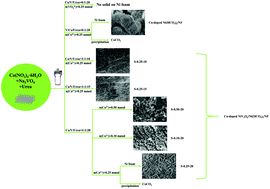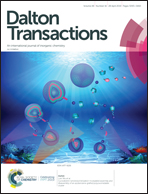Co-Incorporated NiV2O6/Ni(HCO3)2 nanoflake arrays grown on nickel foam as a high-performance supercapacitor electrode†
Abstract
Co-Incorporated NiV2O6/Ni(HCO3)2 arrays with different morphologies can grow on nickel foam (NF) via a mild one-step hydrothermal method. Among them, S-0.5-20 and S-0.25-20 were obtained at a 1 : 1 : 20 molar ratio of Co/V/urea with 0.5 and 0.25 mmol Co(NO3)2, respectively. They demonstrate high areal capacities of 0.99 mA h cm−2 (7.94 F cm−2) and 0.56 mA h cm−2 (4.48 F cm−2) at 1 mA cm−2, respectively, which are superior to that of Co-incorporated Ni(HCO3)2/NF synthesized in the absence of Na3VO4. S-0.25-20 possesses good rate capability with 82.1% retention when the current density is increased 20-fold, and it shows superior long-term durability with 106.2% retention of the initial capacity after 10 000 charging/discharging cycles at 100 mA cm−2. These results are associated with the porous and orderly hierarchical Co-incorporated NiV2O6/Ni(HCO3)2 nanoflake arrays directly grown on the Ni foam. Moreover, due to the synergetic effect of the individual components, electrons can be transferred from V centers to Ni active sites, thus improving the stability of the vanadate. The generation of more active species, such as Co3+, during cycling could account for the increased capacity. A S-0.25-10//activated carbon (AC) asymmetrical supercapacitor shows a high energy density of 0.533 mW h cm−2 at a power density of 0.232 mW cm−2 (0.415 mW h cm−2 at 4.983 mW cm−2). Furthermore, the formation mechanism of the Co-incorporated NiV2O6/Ni(HCO3)2 nanoflake arrays is proposed.



 Please wait while we load your content...
Please wait while we load your content...